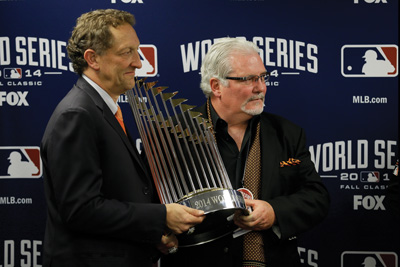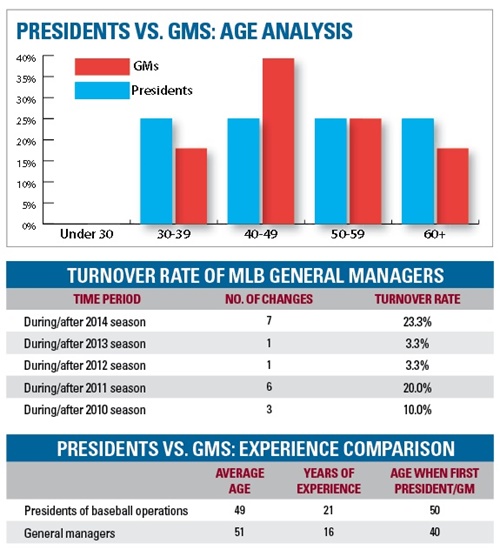Major League Baseball has now played about a third of its season, perhaps too early to draw conclusions about the front office of MLB teams. However, it is not too early to fire managers — Miami and Milwaukee have already done so. Several other managers are on the hot seat, and there is some speculation on changing some front office executives, as well, although owners usually take a longer view by looking to the future while evaluating their performance.
So while it may be too early to draw conclusions, it is not too early to compare the records of teams with presidents of baseball operations with those that have general managers. Teams with presidents have a .506 win percentage (five games over .500), while teams with general managers have a .498 win percentage (five games under .500). It will be interesting to follow the records of these two groups.
A previous article (“How leadership shift has changed look of MLB front offices,” SportsBusiness Journal, March 16-22, 2015) outlined the shift in MLB front offices in recent years. Several teams have hired presidents of baseball operations above the general manager and directly reporting to ownership on the baseball side of a front office. This article will take a look at the profile of the presidents of baseball operations and compare it to the profile of GMs. The small sample size of presidents makes it unclear if the data is statistically significant or if it is just a trend away from the norm, but the large number of GMs allows for a very reliable data set.
■ Recent trends
 |
The Giants’ Sabean (right) was promoted from GM to executive VP at the season’s start.
Photo by: GETTY IMAGES
|
Most offseasons see turnover at the helm of MLB organizations, with most but not all being driven by consistent losing records and/or failed plans. In the most recent offseason, seven teams made GM changes. Colorado, Arizona, San Diego and the Los Angeles Dodgers all hired new GMs. Atlanta decided not to hire a GM for now, possibly allowing time to groom an assistant GM to be the next GM. Matthew Silverman of the Tampa Bay Rays took over Andrew Friedman’s (departed for the Dodgers) position as the president of baseball operations, leaving the organization without anyone with the GM title. Additionally, at the start of the 2015 season, Brian Sabean was promoted to executive vice president of baseball operations for the San Francisco Giants, while assistant GM Bobby Evans assumed the assistant vice president and GM position.
Over the past five years, dating to 2010, the most recent offseason ranks first for the number of changes at the GM position. And the changes were not all for the usual reason of poor performance. The only other year with more than three changes was 2011, when there were six GM changes (representing 20 percent of the league’s teams). Such a high turnover rate affects the average tenure of a GM in the league. As of April of this year, that average tenure was just under six years.
■ Profiling MLB Presidents of Baseball Operations
There are currently eight presidents of baseball operations in the league, and, from the data collected, the average age at which presidents of baseball operations reach this position is 50. Four of the eight were within three years of 40 when they reached the position. Tony La Russa (70) and John Hart (66) skew the data somewhat. The background of each president is even more important. All eight have undergraduate degrees, which is not surprising since close to 90 percent of GMs have an undergraduate degree. Two (La Russa and Theo Epstein) have advanced degrees, both with law degrees.
As for on-field experience at the major league level, only three (La Russa, Sabean and Hart) have managed and coached, and only one (La Russa) made it to the major leagues as a player. Five played professional baseball, while two (Epstein and Silverman) did not play at the college level (both played in high school).
An important work-experience factor to note is that six of the eight presidents have at one point been a GM (75 percent). Only Silverman and La Russa were not, but they both served in very senior front-office executive positions either in their current organization or another one.
On average, the group of eight spent more than 21 years (ranging from 11 to 39 years of experience) working in baseball before attaining the position of president of baseball operations. LaRussa has had a different career path due to his extensive on-field background, with his work experience including a 33-year managerial career and a six-year MLB playing career. It should also be noted that some might argue that his managerial and playing career should not be included in this calculation of previous work experience for a president’s position because it was not in the front office.
Hart also gained a significant amount of on-field experience (seven years) before joining a front office. Not including La Russa’s 39 years in the industry and Hart’s seven years as a manager and then third base coach in the major leagues, the maximum would be Sabean’s 29 years in the front office, and the average work experience would decrease to just under 16 years. On either basis for evaluation, this group of eight baseball executives has had significant related work experience before being appointed to their posts of president of baseball operations.
■ Comparing the Profiles of Presidents and General Managers
The average age of the current GMs (28 individuals, because Tampa Bay and Atlanta have no one in their GM positions) is 51, two years older than that of the presidents. Also, the age distribution peaks in the 40- to 49-year-old bracket for the GMs but is consistent across the age brackets for presidents.
 |
As would be expected, the presidents of baseball operations have, on average, accumulated more experience in the baseball industry than the GMs have. As noted above, presidents have two decades of experience on average, whereas today’s GMs have only 16. It makes sense that a president, a higher position in the ranking of front offices, would require more experience to reach his position, especially seeing as most of the presidents had previously been a GM. To further back this point of view, the average age at which a GM reaches his position is 40, whereas the average age an individual reaches the president of baseball operations position is 50. Assuming most executives begin their careers at approximately the same age, there is an average of a 10-year gap in experience.
It is interesting to note that of the four presidents younger than 50 (Silverman, Friedman, Epstein, and Miami’s Michael Hill), all four spent at least nine years with one club before being named president.
Now that there are a significant number of presidents, it will be interesting to see if the current trends continue. In five years, how many teams will have a president of baseball operations? And then, of course, it will be interesting to see the backgrounds of the people hired for those positions.
It also will be interesting to see if the trend of hiring a president above a GM occurs in other professional team sports. MLB leads in this front-office structure. Currently, only 22 clubs in the NFL, NBA and NHL out of 92 have a president.
Glenn M. Wong (gwong@isenberg.umass.edu) is a professor in the Mark H. McCormack Department of Sport Management in the Isenberg School of Management at the University of Massachusetts. Richard Conway, UMass Amherst MBA/MS in Sport Management candidate (2015), assisted with research for this column.






